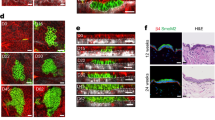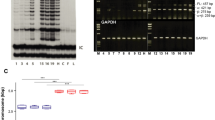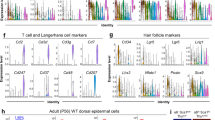Abstract
Focal adhesion kinase (FAK) is a critical component in transducing signals downstream of both integrins and growth factor receptors. To determine how the loss of FAK affects the epidermis in vivo, we have generated a mouse model with a keratinocyte-restricted deletion of fak (FAKK5 KO mice). FAKK5 KO mice displayed three major phenotypes – irregularities of hair cycle, sebaceous glands hypoplasia, and a thinner epidermis – pointing to defects in the proliferative capacity of multipotent stem cells found in the bulge. FAK-null keratinocytes in conventional primary culture undergo massive apoptosis hindering further analyses, whereas the defects observed in vivo do not shorten the mouse lifespan. These results suggest that the structure and the signaling environment of the native tissue may overcome the lack of signaling through FAK. Our findings point to the importance of in vivo and three-dimensional in vitro models in analyses of cell migration, proliferation, and survival. Surprisingly, the difference between FAKloxP/+ and FAKK5 KO mice in wound closure was not statistically significant, suggesting that in vivo loss of FAK does not affect migration/proliferation of basal keratinocytes in the same way as it affects multipotent stem cells of the skin.
This is a preview of subscription content, access via your institution
Access options
Subscribe to this journal
Receive 50 print issues and online access
$259.00 per year
only $5.18 per issue
Buy this article
- Purchase on Springer Link
- Instant access to full article PDF
Prices may be subject to local taxes which are calculated during checkout





Similar content being viewed by others
Abbreviations
- E:
-
embryonic day
- ECM:
-
extracellular matrix
- P:
-
postnatal day
References
Abbi S, Guan JL . (2002). Histol Histopathol 17: 1163–1171.
Adams JC, Watt FM . (1989). Nature 340: 307–309.
Alonso L, Fuchs E . (2003). Proc Natl Acad Sci USA 100: 11830–11835.
Andre E, Becker-Andre M . (1993). Biochem Biophys Res Commun 190: 140–147.
Beggs HE, Schahin-Reed D, Zang K, Goebbels S, Nave KA, Gorski J et al. (2003). Neuron 40: 501–514.
Brakebusch C, Grose R, Quondamatteo F, Ramirez A, Jorcano JL, Pirro A et al. (2000). EMBO J 19: 3990–4003.
Cary LA, Chang JF, Guan JL . (1996). J Cell Sci 109: 1787–1794.
Coulombe PA . (1997). Biochem Biophys Res Commun 236: 231–238.
Cui CY, Durmowicz M, Ottolenghi C, Hashimoto T, Griggs B, Srivastava AK et al. (2003). Hum Mol Genet 12: 2931–2940.
Damsky CH, Ilic D . (2002). Curr Opin Cell Biol 14: 594–602.
Fincham VJ, Frame MC . (1998). EMBO J 17: 81–92.
Frisch SM, Vuori K, Ruoslahti E, Chan-Hui PY . (1996). J Cell Biol 134: 793–799.
Furuta Y, Ilic D, Kanazawa S, Takeda N, Yamamoto T, Aizawa S . (1995). Oncogene 11: 1989–1995.
Grose R, Hutter C, Bloch W, Thorey I, Watt FM, Fassler R et al. (2002). Development 129: 2303–2315.
Hanks SK, Ryzhova L, Shin NY, Brabek J . (2003). Front Biosci 8: d982–d996.
Hauck CR, Sieg DJ, Hsia DA, Loftus JC, Gaarde WA, Monia BP et al. (2001). Cancer Res 61: 7079–7090.
Ilic D, Almeida EA, Schlaepfer DD, Dazin P, Aizawa S, Damsky CH . (1998). J Cell Biol 143: 547–560.
Ilic D, Furuta Y, Kanazawa S, Takeda N, Sobue K, Nakatsuji N et al. (1995a). Nature 377: 539–544.
Ilic D, Furuta Y, Suda T, Atsumi T, Fujimoto J, Ikawa Y et al. (1995b). Biochem Biophys Res Commun 209: 300–309.
Ilic D, Genbacev O, Jin F, Caceres E, Almeida EA, Bellingard-Dubouchaud V et al. (2001). Am J Pathol 159: 93–108.
Ilic D, Kovacic B, Johkura K, Schlaepfer DD, Tomasevic N, Han Q et al. (2004). J Cell Sci 117: 177–187.
Klemke RL, Leng J, Molander R, Brooks PC, Vuori K, Cheresh DA . (1998). J Cell Biol 140: 961–972.
Kovacic-Milivojevic B, Roediger F, Almeida EA, Damsky CH, Gardner DG, Ilic D . (2001). Mol Biol Cell 12: 2290–2307.
Liu Y, Lyle S, Yang Z, Cotsarelis G . (2003). J Invest Dermatol 121: 963–968.
Ma DR, Yang EN, Lee ST . (2004). Ann Acad Med Singapore 33: 784–788.
McLean GW, Avizienyte E, Frame MC . (2003). Expert Opin Pharmacother 4: 227–234.
McLean GW, Komiyama NH, Serrels B, Asano H, Reynolds L, Conti F et al. (2004). Genes Dev 18: 2998–3003.
Mitra SK, Hanson DA, Schlaepfer DD . (2005). Nat Rev Mol Cell Biol 6: 56–68.
Morasso MI, Tomic-Canic M . (2005). Biol Cell 97: 173–183.
Nolan K, Lacoste J, Parsons JT . (1999). Mol Cell Biol 19: 6120–6129.
Oktay M, Wary KK, Dans M, Birge RB, Giancotti FG . (1999). J Cell Biol 145: 1461–1469.
Parsons JT . (2003). J Cell Sci 116: 1409–1416.
Paus R, Muller-Rover S, Van Der Veen C, Maurer M, Eichmuller S, Ling G et al. (1999). J Invest Dermatol 113: 523–532.
Raghavan S, Bauer C, Mundschau G, Li Q, Fuchs E . (2000). J Cell Biol 150: 1149–1160.
Ramirez A, Page A, Gandarillas A, Zanet J, Pibre S, Vidal M et al. (2004). Genesis 39: 52–57.
Schlaepfer DD, Hanks SK, Hunter T, van der Geer P . (1994). Nature 372: 786–791.
Schlaepfer DD, Mitra SK, Ilic D . (2004). Biochim Biophys Acta 1692: 77–102.
Sieg DJ, Hauck CR, Ilic D, Klingbeil CK, Schaefer E, Damsky CH et al. (2000). Nat Cell Biol 2: 249–256.
Stenn KS, Paus R . (2001). Physiol Rev 81: 449–494.
Tumbar T, Guasch G, Greco V, Blanpain C, Lowry WE, Rendl M et al. (2004). Science 303: 359–363.
Vaezi A, Bauer C, Vasioukhin V, Fuchs E . (2002). Dev Cell 3: 367–381.
Wary KK, Mariotti A, Zurzolo C, Giancotti FG . (1998). Cell 94: 625–634.
Zhu AJ, Haase I, Watt FM . (1999). Proc Natl Acad Sci USA 96: 6728–6733.
Acknowledgements
The work is supported by grant from National Cancer Institute (CA87652) to D Ilic. We thank Drs C Damsky and D Schlaepfer (Scripps) for a critical reading of the manuscript and E Gering (SFSU) for editorial assistance. This investigation was conducted in a facility constructed with support from the Research Facilities Improvement Program Grant number C06RR16490.
Author information
Authors and Affiliations
Corresponding author
Rights and permissions
About this article
Cite this article
Essayem, S., Kovacic-Milivojevic, B., Baumbusch, C. et al. Hair cycle and wound healing in mice with a keratinocyte-restricted deletion of FAK. Oncogene 25, 1081–1089 (2006). https://doi.org/10.1038/sj.onc.1209130
Received:
Revised:
Accepted:
Published:
Issue Date:
DOI: https://doi.org/10.1038/sj.onc.1209130
Keywords
This article is cited by
-
Integrin-mediated regulation of epidermal wound functions
Cell and Tissue Research (2016)
-
Genetically modified laboratory mice with sebaceous glands abnormalities
Cellular and Molecular Life Sciences (2016)
-
Protein Tyrosine Kinase 6 Regulates UVB-Induced Signaling and Tumorigenesis in Mouse Skin
Journal of Investigative Dermatology (2015)
-
Targeting Focal Adhesion Kinase in Fibrotic Diseases
BioDrugs (2013)
-
Focal adhesion kinase links mechanical force to skin fibrosis via inflammatory signaling
Nature Medicine (2012)



